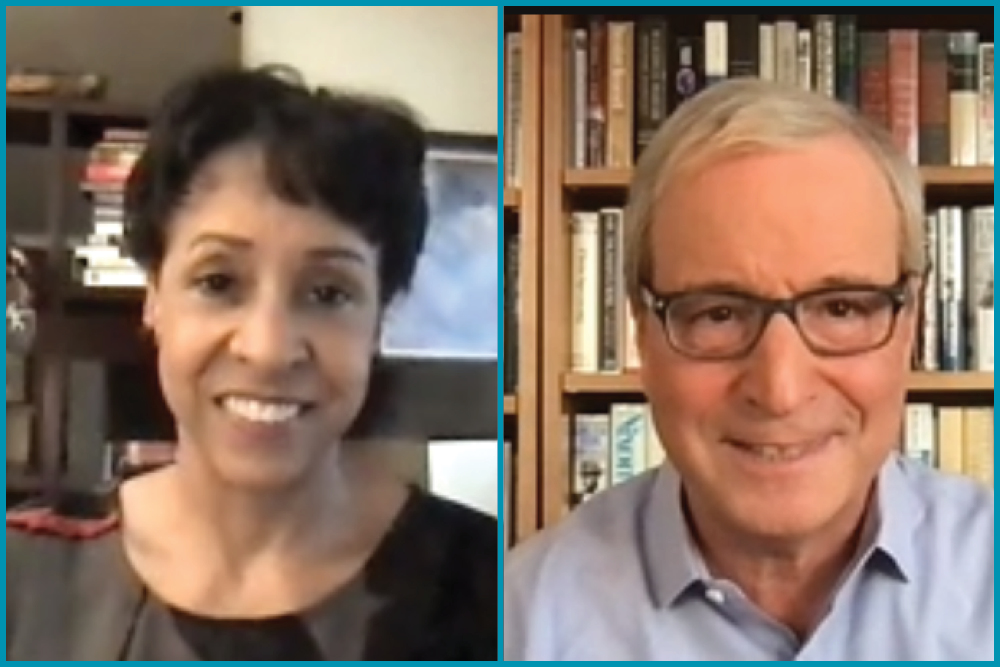
Sandy Banks and Ronald Brownstein discuss "How Did Politics and Pop Culture Become One?"
Longtime political journalist Ronald Brownstein paid a visit to Zócalo yesterday to speak about his new book, Rock Me On the Water: 1974- The Year Los Angeles Transformed Movies, Music, Television, and Politics.
In conversation with Los Angeles Times columnist Sandy Banks, Brownstein, who is a senior editor at the Atlantic and senior political analyst at CNN, explored the complexities of the early 1970s, and the era’s relationship to the mainstream social engagement of pop culture today.
The discussion, titled “How Did Politics and Pop Culture Become One?,” captured a moment of change, as the entertainment industry as a whole struggled to appeal to a new, younger audience in the early ’70s. For Brownstein, the year 1974, in particular, became a pop-cultural crucible, as mainstream music, film, and television were simultaneously at a peak of creative output and sociopolitical critique. Musicians Jackson Browne, Linda Ronstadt, and the Eagles each released career-defining albums, while an open, collaborative atmosphere flourished in Laurel Canyon, and politically incisive films like Chinatown hit theaters. And it was the only year that the socially engaged TV series All in the Family, The Mary Tyler Moore Show, and M*A*S*H were on television at the same time.
Those iconic works were able to reach audiences because of the rise of the Baby Boomers, who represented an oncoming tide whose sheer size overwhelmed the older audiences to which media had previously catered. This new generation was demographically more diverse, steeped in 1960s progressivism and the Civil Rights Movement, and had the economic clout to drive industries to cater to their zeitgeist.
It was a marked change from the 1960s, Brownstein explained, when film and television “steadfastly ignored all the changes that were happening around them.” Take Walter Cronkite: Brownstein pointed out that the broadcast titan “would spend half an hour every night documenting all the new fissures opening in American life, and then the CBS prime-time [programming], and the other networks would spend the next three-and-a-half hours trying to erase them from viewers’ minds.”
But the dial moved in the ’70s, as attitudes that had been considered radical or countercultural in the years leading up to them—including equal rights for Black people, gay people and women—were given new visibility through this shift in mainstream entertainment.
It was that same transformation, Brownstein argued, that inspired a stark cultural divide that laid the foundation for a divisive partisanship that has characterized American politics ever since. Over the course of his career, Brownstein observed how this led to the American political scene becoming dominating by the “culture wars.” If the 1960s was the “big bang” that laid the foundation for this transformation, he said, it was the 1970s where that change was reinforced by a growing rift between conservative politics and the entertainment industries.
“The early ’70s was a collision between this massive younger generation that was bringing its set of new cultural and social attitudes into society, and an older generation that was, by and large, really unnerved by those changes,” he said. Conservative politicians like Richard Nixon and Ronald Reagan learned they could win elections by appealing to the older electorate’s fear of cultural change. At the same time, the entertainment industry faced a drastically opposite economic incentive to reach a younger, more progressive audience. The powerful creative energy ascendant in Los Angeles that resulted produced a kind of “golden hour,” he said. He recounted that the various artists he interviewed described a newly open, expressive, and collaborative atmosphere, with a distinctive sensation that creative and radical forces were suddenly beginning to coalesce.
But that bubble burst “once it was clear that fundamental revolution was not coming to the country,” said Bronstein. In turn, movies and television reverted to less-challenging work. Because the increasing representation of Black, female, and other marginalized voices in the early ’70s had been mostly limited to on-screen talent, rather than in executive roles, they, too, had less power to push back against this tide.
Still, said Bronstein, the baseline had undeniably shifted, as the increasing visibility and attention to diversity made mainstream the progressive attitudes that had grown through the 1960s, which have been maintained and expanded.
That unique moment in 1970s L.A. both prefigures, and allowed for our own, Brownstein argued. He pointed to a lineup of socially critical films like Judas and the Black Messiah and Nomadland, which stand in the running for Academy Awards, and studios bend to audiences’ demand for far greater racial and gender diversity and equal representation as creators, producers, stories and talent. And as certain reactionary politicians stoke fear of change across large swaths of the nation at the same time.
Now, as then, Brownstein places his bets on pop culture. Pop culture is an indicator of social attitudes ten years on, he said, speculating that a decade from now, ideas that may now seem radical will gain greater airtime and wider acceptance. “You can mobilize voters, on a short-term basis, by promising to stop change. But you can’t actually stop the change,” he said.




Send A Letter To the Editors